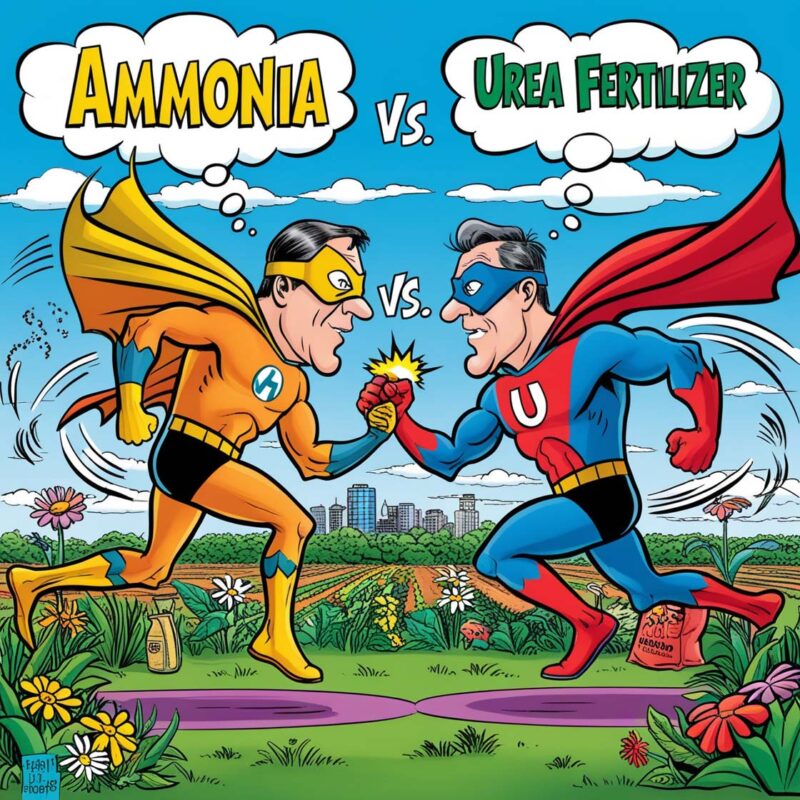Ammonia vs. Urea Fertilizer

Ammonia vs. Urea Fertilizer: Comparison, Applications, and Benefits in Agriculture
Ammonia and urea are two of the most widely used nitrogen-based fertilizers in modern agriculture. Both play a crucial role in enhancing soil fertility and boosting crop yields, but they have distinct properties, applications, and advantages. In this article, we will explore the differences between ammonia and urea, their specific applications in agriculture, how they perform in various agricultural contexts, their benefits and drawbacks, and why purchasing these products from Persia B2B can provide significant cost savings—up to 20% less than global prices. Let's dive into the key differences between these two fertilizers and compare their overall efficiency.
1. What is Ammonia?
Ammonia (NH₃) is a compound made up of nitrogen and hydrogen. It is a colorless gas with a pungent odor and is produced primarily through the Haber-Bosch process, where nitrogen from the air is combined with hydrogen at high pressure and temperature. Ammonia is a key raw material for the production of fertilizers, industrial chemicals, and other products.
Key Properties of Ammonia:
- Chemical Formula: NH₃
- Appearance: Colorless gas
- Odor: Strong, pungent smell
- Density: 0.73 g/L (at 0°C)
- Molar Mass: 17.03 g/mol
Ammonia in its anhydrous form is often used directly as a fertilizer or can be converted into other nitrogenous fertilizers, such as urea and ammonium nitrate.

2. What is Urea?
Urea (CO(NH₂)₂) is a solid organic compound that is commonly used as a nitrogen fertilizer in agriculture. It is produced by synthesizing ammonia and carbon dioxide under high pressure. Urea is highly soluble in water and is often used as a granular fertilizer or in liquid form, depending on application requirements.
Key Properties of Urea:
- Chemical Formula: CO(NH₂)₂
- Appearance: White crystalline solid
- Solubility: Highly soluble in water
- Molar Mass: 60.06 g/mol
Urea is one of the most widely used fertilizers globally due to its high nitrogen content, which makes it efficient for promoting plant growth.
3. Differences Between Ammonia and Urea
While both ammonia and urea are nitrogen fertilizers, there are several critical differences between the two that affect their application, efficiency, and impact on agriculture.
| Factor | Ammonia | Urea |
|---|---|---|
| Form | Gas (Anhydrous ammonia or ammonia solution) | Solid (Granular or liquid) |
| Nitrogen Content | Typically 82% nitrogen by weight (in anhydrous form) | Typically 46% nitrogen by weight |
| Application | Directly injected into soil or used in ammonium salts | Broadcasted, incorporated into the soil, or applied in liquid form |
| Cost | Generally cheaper to produce | More expensive to produce, but easier to handle and store |
| Speed of Action | Acts quickly upon application | Slower release due to its need to break down in soil |
| Volatility | Highly volatile, can lead to nitrogen loss if not applied correctly | Less volatile, more stable in the soil |
4. Applications in Agriculture
Both ammonia and urea are used to provide essential nitrogen to crops, but their methods of application and efficiency differ.
Ammonia in Agriculture:
Ammonia is often applied directly to the soil as anhydrous ammonia or in a diluted form (ammonium hydroxide). It is a highly effective source of nitrogen, but because of its volatility, it must be injected into the soil to minimize nitrogen loss. Ammonia is often used in large-scale agricultural operations where soil nitrogen needs are high, such as in corn and wheat production.
Benefits of Ammonia in Agriculture:
- High Nitrogen Content: Ammonia contains a high percentage of nitrogen, making it an efficient fertilizer for boosting crop growth.
- Immediate Effect: Ammonia provides an immediate nitrogen boost to plants.
- Cost-Effective: Ammonia is usually cheaper than urea on a per-unit nitrogen basis.
Urea in Agriculture:
Urea is widely used as a fertilizer due to its high nitrogen content and ease of use. It is often applied in granular or liquid form, and because it is less volatile than ammonia, it can be applied directly to the soil without the need for specialized equipment.
Benefits of Urea in Agriculture:
- Ease of Use: Urea is easier to handle and apply compared to ammonia, as it doesn’t require specialized equipment for injection.
- High Nitrogen Content: Urea provides a significant nitrogen boost to crops.
- Slow-Release: Urea has a slower release rate, which means that it feeds plants over a longer period, reducing the risk of nitrogen loss through leaching or volatilization.
5. Efficiency and Effectiveness in Agriculture
When comparing the efficiency of ammonia and urea in agricultural applications, several factors must be considered, including the nitrogen release rate, soil conditions, and crop requirements.
Ammonia Efficiency:
Ammonia acts rapidly in soil and provides an immediate supply of nitrogen to plants. However, because ammonia is highly volatile, improper application methods can lead to nitrogen loss. Ammonia’s efficiency is highly dependent on soil moisture and temperature, as it tends to escape into the atmosphere if not properly incorporated into the soil.
Urea Efficiency:
Urea, on the other hand, is less volatile and has a slower release rate compared to ammonia. It requires microbial activity in the soil to break down into ammonium and nitrate, which are then available to plants. This slower breakdown process can be more efficient in terms of reducing nitrogen losses, as it provides a more sustained release of nitrogen over time.
6. Cost-Effectiveness and Economic Considerations
Both ammonia and urea are commonly used by farmers, but the cost-effectiveness of each depends on various factors, such as the cost of production, the application method, and the specific crop being grown.
Ammonia:
Ammonia tends to be cheaper to produce and apply compared to urea. However, the cost of specialized equipment needed for ammonia injection, as well as the potential nitrogen loss due to volatilization, can increase overall costs.
Urea:
While urea is generally more expensive than ammonia, it is easier to handle and store, and the risk of nitrogen loss is lower. Urea also provides a slower, more sustained nitrogen release, which can lead to better long-term crop yields, making it a more cost-effective option in some cases.
7. Advantages and Disadvantages of Ammonia and Urea
Advantages of Ammonia:
- Cost-Effective: Lower production and application costs.
- High Nitrogen Content: Provides a quick nitrogen boost for fast-growing crops.
- Efficient for Large-Scale Farming: Ideal for large-scale agricultural operations.
Disadvantages of Ammonia:
- Volatility: Highly volatile, can result in nitrogen loss if not properly applied.
- Specialized Equipment Needed: Requires ammonia injectors for proper application.
- Soil Sensitivity: Soil moisture and temperature affect ammonia efficiency.
Advantages of Urea:
- Ease of Use: Can be applied with basic equipment.
- Slower Release: Reduces nitrogen loss and provides a more sustained release of nutrients.
- Lower Volatility: Less prone to nitrogen loss compared to ammonia.
Disadvantages of Urea:
- More Expensive: Typically more expensive than ammonia on a per-unit nitrogen basis.
- Slower Action: Provides a slower nitrogen release, which may not be suitable for all crops.


8. Why Buy Ammonia and Urea from Persia B2B?
By purchasing ammonia and urea from Persia B2B, you can benefit from:
- Competitive Pricing: Both ammonia and urea are available at 20% lower than global prices, offering significant cost savings.
- Bulk Purchasing Options: Ideal for large-scale agricultural businesses, Persia B2B provides flexible bulk purchasing options for fertilizers.
- Quality Assurance: All products from Persia B2B undergo strict quality checks to ensure consistency and effectiveness.
- Specialized Services: Persia B2B offers tailored shipping and packaging solutions to meet your business needs, ensuring your order is handled efficiently.
9. Conclusion
Ammonia and urea are both essential fertilizers in modern agriculture, each with its unique advantages and applications. Ammonia is typically cheaper and provides a quick nitrogen boost, while urea offers a slower, more controlled release of nutrients. The choice between ammonia and urea depends on factors such as soil conditions, crop type, and cost considerations.
For businesses looking to maximize their agricultural productivity while minimizing costs, Persia B2B offers a compelling solution. By sourcing ammonia and urea from Persia B2B, you can access these critical fertilizers at 20% less than global prices, providing a significant advantage in the competitive agricultural sector.








































